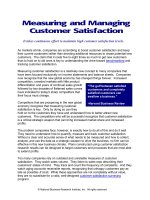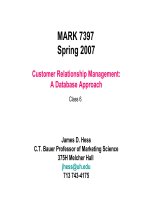Customer Once Client Forever ppt
Bạn đang xem bản rút gọn của tài liệu. Xem và tải ngay bản đầy đủ của tài liệu tại đây (1.06 MB, 300 trang )
Foreword By Paul B. Brown, co-author of Customers for Life
Customer Once,
Client Forever
Customer Once,
Client Forever
12 Tools f o r Building
Lifetime Business
Relatio nship s
RICHARD BUCKINGHAM
RICHARD BUCKINGHAM
Customer Once,
Client Forever
RICHARD BUCKINGHAM
KIPLINGER BOOKS
Washington, D.C.
Foreword By Paul B. Brown, co-author of Customers for Life
Customer Once,
Client Forever
12 Tools for Building Lifetime Busin ess Relation ships
Published by
The Kiplinger Washington Editors, Inc.
1729 H Street, N.W.
Washington, DC 20006
Library of Congress Cataloging-in-Publication Data
Buckingham, Richard, 1963-
Customer once, client forever : 12 tools for building lifetime business
relationships / Richard Buckingham.
p. cm.
Includes bibliographical references and index.
ISBN 0-938721-82-8 (alk. paper)
1. Customer services United States. 2. Consumer satisfaction United States.
I. Title.
HF5415.5 .B799 2001
658.8’12 dc21 00-047823
© 2001 by the Kiplinger Washington Editors, Inc. All rights reserved. No part of
this book may be reproduced or transmitted in any form or by any means, electronic
or mechanical, including photocopying, recording, or by an information storage
and retrieval system, without the written permission of the Publisher, except where
permitted by law.
This publication is intended to provide guidance in regard to the subject matter
covered. It is sold with the understanding that the author and publisher are not
herein engaged in rendering legal, accounting, tax or other professional services.
If such services are required, professional assistance should be sought.
First edition. Revised 12/01. Printed in the United States of America.
9 8 7 6 5 4 3 2
Kiplinger publishes books and videos on a wide variety of personal-finance and
business-management subjects. Check our Web site (www.kiplinger.com) for a complete
list of titles, additional information and excerpts. Or write:
Cindy Greene
Kiplinger Books & Tapes
1729 H Street, N.W.
Washington, DC 20006
e-mail:
To order, call 800-280-7165; for information about volume discounts, call 202-887-6431.
Dedication
T
his book is dedicated with respect and grat-
itude to my clients who have allowed me
the opportunity to serve them.
And a special dedication to my father, John D.
Buckingham, and everyone else I had the oppor-
tunity to work with at Sun Control Systems. My
father taught me the importance of having a
healthy respect for your clients. I could never have
written this book without the experience of work-
ing at Sun Control. Thank you.
vii
Acknowledgments
I
am indebted to many people for their advice
and assistance throughout the development of
this book:
To all the people in my workshops who over
the past seven years, either by filling out the feed-
back forms or asking questions, continually
improved the quality of the material.
To my clients and associates who took the time
to read and comment on earlier manuscripts. I am
especially grateful to Randy Shackelford, Frank
Bloom, Susan Matthews, Brent Kynoch and my
brother Dan Buckingham. Their input has made
this a much better book.
To Kent Slepicka. Kent’s level judgment,
intellect and good humor were instrumental in
completing this book. In addition, I’m grateful to
Kent for his many suggestions in polishing the
GoalStar margin, call-out notes.
To Paul B. Brown, co-author of
Customers for
Life, for his guidance and suggestions. Customers
for Life is the best business book I have ever read.
Buy it and read it.
To everyone at Kiplinger, all of whom have
been a pleasure to work with:
To Knight Kiplinger, who took my telephone
request for a referral to a literary agent and
referred me instead to Kiplinger Books. Because
of his interest, Customer Once, Client Forever is
the Kiplinger Book that you are now holding.
To David Harrison, who strikes that perfect
balance of getting things done and being a plea-
sure to work with. Thanks also to Pat Esswein,
who I admire for her desire to always find that
exact word to properly convey an idea.
Lastly, thanks to Rosemary Neff, who copy-
edited and proofed the book, and to Heather
Waugh who designed the book and put together a
winning and inviting cover design.
To the many outstanding teachers in my life,
especially Ed Sundt, Charles Wortman and Keith
Saylor. All three taught me that how you arrive at
an answer is as important as the answer itself.
They taught me to think.
To my mother, Betty Buckingham, because
everything in this book is second nature to her.
Finally, to my family and friends, then and
now, who supported and encouraged me during
this endeavor.
R
ICHARD BUCKINGHAM
January 2001
Bethesda, Maryland
viii
Table of Contents
Acknowledgments vii
Foreword
xiii
By Paul B. Brown, co-author, Customers for Life
Introduction xv
By Knight A. Kiplinger, Editor-in-Chief, The
Kiplinger Letter, Kiplinger’s Personal Finance
Magazine, and Kiplingerforecasts.com
How to Maximize Your Use of This Book xxi
Understanding the Philosophy
of Lifetime Clients
1
Defining a lifetime client • Profitability is in
the lifetime relationship • Seven compelling
reasons to keep clients for life • Recognizing
lifetime client opportunities • How to turn
satisfied customers into loyal lifetime clients
LIFETIME TOOL 1:
Continually Improving Yourself 19
My three phases of continual improvement •
Three improvement strategies • Adopt a daily
attitude of self-assessment • Continual improve-
ment is not just for novices • Improving—daily
• Putting together the three strategies
LIFETIME TOOL 2:
Properly Preparing Yourself to Win
the Lifetime Relationship
49
Understand your market, all your products and
services, and your competition • Understand the
four client needs • Becoming the trusted adviser
LIFETIME TOOL 3:
Chasing the Client, Not the Dollar 67
What’s wrong with the profit-first philosophy?
• Redefining business success
LIFETIME TOOL 4:
Superserving Your Clients 85
Superserve your clients • Always be polite,
kind and generous to your clients
LIFETIME TOOL 5:
Building Lifetime Client Rapport
97
Rapport-building strategies
LIFETIME TOOL 6:
Hearing What Your Clients
Are Actually Saying
117
Active listening strategies
LIFETIME TOOL 7:
Asking the Right Questions
137
Questions to ask to develop lifetime clients
• Ask the right way • The benefits of asking
the right questions
LIFETIME TOOL 8:
Systemizing Your Business 155
What is a system? • Why you need a business
system • Five steps to systemizing your business
LIFETIME TOOL 9:
Gaining Valuable Client Feedback
185
Why is client feedback important? • Suggestions
for setting up a client panel • Client survey forms
• Other ways to get client feedback • What to
do with the feedback you get
LIFETIME TOOL 10:
Converting Complaining Clients
Into Lifetime Clients 209
The impact of client complaints • No news is
not necessarily good news • The cost of not
responding to complaints • Why do clients leave?
• Strategies for turning angry clients into loyal,
lifetime clients • Other strategies to handle angry
clients • Strategies to win back “lost” clients
LIFETIME TOOL 11:
Properly Managing Your Client Base 233
How do you current client relationships
measure up? • The GoalStar Lifetime Client
Model • Determining the value of a lifetime
client • Maintaining your client base •
Dealing with “deadwood” clients
LIFETIME TOOL 12:
Expanding Your Client Base
249
Do outstanding work • Always ask for referrals
• Learn about prospective clients • Give
qualified referrals to get referrals • Build
bridges in giving referrals • Measure referrals
Today Is “Monday Morning” 259
How will you apply these strategies Monday
morning?
Appendix: Books That Have Helped Me 263
Index 273
Readership Survey and Order Information
281
About the Author
283
Foreword
W
hile Carl Sewell and I would like to
think our collective good looks had
something to do with the fact that our
book, Customers for Life, has now sold close to a
million copies, the truth is a lot less prosaic.
People are hungry for ways to learn how to turn
good customer service into a business strategy.
This is something that Richard D. Buckingham
understands. In the summer of 1997, Rick contact-
ed me about a book he was writing. He said he
wanted to help his clients—and others—convert
one-time buyers into lifetime clients. Over the past
two years, I have watched a book develop.
Drawing on his own experiences, as well as the
examples of others such as Sam Walton and
Johnson & Johnson, Rick presents a simple,
straightforward strategy for increasing sales—and
profits. Both his approach and his recommenda-
tions are timeless. Customer Once, Client Forever
is a welcome addition to the ongoing effort of
improving the dialogue between companies and
their clients.
Business is as competitive as it has ever been.
You must do all you can to keep your clients for life.
Reading this book is an excellent place to begin.
P
AUL B. BROWN
Co-author, Customers for Life
Cape Cod Bay, Massachusetts
xiii
Introduction
S
everal times each year, my assistant will buzz
my intercom and tell me there’s someone on
the phone who is very upset and insists on
talking with “Mr. Kiplinger.” She has already
offered, very courteously, to help him with his
problem or refer him to someone who can, but he
is adamant about talking to “the man at the top.”
So what do I do? Ask my assistant to tell the
caller I’m in a meeting or out of town? No, I take
the call just as my grandfather took such calls
decades ago, and just as my father and I have done
for many years. And if the person happened to
write me, rather than call, I write him back, with a
personal letter.
There are probably plenty of corporate CEOs
who feel that spending a few minutes on the
phone with aggrieved customers is beneath them,
or a distraction from their more important duties.
But at the Kiplinger publishing organization,
we’ve never felt that way. To us, our subscribers—
whom we consider to be clients, rather than mere-
ly customers—are the most important people in
our world. If I don’t have time to talk with them—
whenever they call, for whatever reason—whom
should I have time for?
So I take these calls. The caller might be upset
about our mishandling of his subscription renew-
al, or he might be angry about something we
wrote in one of our periodicals—something he
xv
considers to be inaccurate, unfair or injurious to
his business.
The first thing I say is, “How can I help you?”
and then I listen. The caller is often so surprised
to be talking with “the man at the top,” and so sur-
prised that I am really interested in his problem,
that he calms down immediately. If our company
made a mistake, I apologize at once, no excuses,
and offer to make restitution, by extending his
subscription at no extra charge or sending him a
gift copy of one of our books. If it’s an editorial
issue on which I can’t make amends, I thank him
for his opinion and tell him that, while I may not
agree, I respect his point of view. If the caller
seems inclined to talk a bit longer, I ask him what
field he is in, how his business is doing, and what
new trends and challenges he’s facing. By the end
of the talk, after I’ve thanked him for his patron-
age, we usually part as friends.
These conversations sometimes take 10 or 15
minutes—all for a subscriber who might add as lit-
tle as $20, $60 or $80 a year to our revenue,
depending on which of our publications he takes.
So is this a waste of my time? Hardly.
You see, a publishing business is a prototype of
the “lifetime client” relationship that Rick
Buckingham is talking about in this wonderful new
book,
Customer Once, Client Forever. Publications
succeed or fail on their ability to renew their sub-
scribers year after year, and this, in turn, is depen-
dent on serving their readers’ needs—producing
the information they want, delivering it fast, and
straightening out the problems that occasionally
arise, with courtesy and efficiency.
Our company has survived and thrived for
more than 80 years because our publications have
high subscription renewal rates—much higher
CUSTOMER ONCE, CLIENT FOREVER
xvi
xvii
Introduction
than similar periodicals. And we have high renew-
al rates because we are fanatical about serving our
subscribers’ needs in any way we can.
As Mr. Buckingham points out throughout this
book, great customer service doesn’t mean you
talk to your clients only when there’s a problem—
quite the opposite. It requires regularly keeping in
touch with them—to inquire about their needs, to
anticipate their concerns and to find out how you
can serve them better.
Mr. Buckingham makes an astute point when
he urges businesses to “under-promise and over-
deliver,” surprising their clients with service that
doesn’t just meet, but exceeds, their expectations.
This is a lesson that we at Kiplinger took to heart
many years ago. Since our founding in 1920, we’ve
been an information service to our subscribers,
not just a publisher. Every subscription, however
modestly priced, carries with it the privilege of
asking our editors for customized information and
judgment on any subject we write about: “What’s
the outlook for natural-gas prices next year?” Or
“Will that new OSHA rule be enacted or post-
poned?” Or “How can I get some information on
trade with Ecuador?”
Relatively few of our subscribers take us up on
this offer in any given week, but when they do, we
respond to their query with speed and accuracy—
and the client is surprised and impressed. We
think this surprising level of personal service is
reflected in our renewal rates, and we hope the
client tells a few friends that “Kiplinger was there
for me when I needed help.”
Is this an expensive way for us to do business?
Sure it is. But retaining loyal clients with top-
notch service is ultimately less expensive—and
much more profitable in the long run—than hav-
xviii
ing to replace disgruntled customers.
That message is at the heart of Mr.
Buckingham’s new book. He is a master salesman
who discovered, by trial and error, that business
success depends not only on offering a quality
product at a fair price but also on delivering that
product with superb service before, during and
after the sale. His book is a readable, entertaining
sales-and-service bible for everyone in business,
from the sales staff and customer-service phone
operators to the highest levels of senior manage-
ment. Extending that old adage, “In successful
companies, everyone sells,” Mr. Buckingham
would add, “Everyone is in client service.”
Mr. Buckingham is a sought-after consultant
and trainer for businesses large and small. In his
seminars and in this book, he makes rich use of
colorful and thoughtful anecdotes about the
best—and worst—practices he has observed in
the businesses that he has served or patronized as
a customer.
There is nothing magical about the lessons in
Customer Once, Client Forever. They are based,
above all, on principles of square-dealing, fair play
and treating your clients the way you wish to be
treated when you’re the customer. But surprising-
ly often, many businesses either never take the
trouble to learn these lessons or forget them in the
frantic press of their daily grind. And, as Mr.
Buckingham points out repeatedly, the most suc-
cessful, client-friendly businesses never rest on
their laurels. They constantly renew their commit-
ment to client service with regular self-assessment,
employee training and benchmarking of their busi-
ness practices.
I learned—and relearned—a lot of valuable
lessons from this book, and I’m sure you will, too.
CUSTOMER ONCE, CLIENT FOREVER
xix
Introduction
From all of us at the Kiplinger organization, our
best wishes to you and your colleagues for suc-
cess in developing your own loyal corps of
“clients forever.”
K
NIGHT A. KIPLINGER
Editor in Chief
The Kiplinger Letter,
Kiplinger’s Personal Finance magazine
and Kiplingerforecasts.com
Washington, D.C.
xxi
How to Maximize
Your Use of
This Book
H
aving read many business books myself
and noticed their lack of user-friendliness,
I developed six features to make Customer
Once, Client Forever as useful as possible to
my readers.
THE 12 LIFETIME TOOLS. To give the book struc-
ture, make it easy to understand and make the
strategies easy to apply, I’ve designed each
Lifetime Tool to build on the one before it. Read
the Table of Contents first to get an overview of
the book and see exactly where we are headed.
It’s best to read each chapter in sequence. The
goal of this book is to offer a comprehensive busi-
ness philosophy.
THE GOALSTAR SIDE NOTES IN THE MARGIN. To
draw out the main nuggets of wisdom and allow
for quick reference, I’ve developed the GoalStar
margin notes (named for my business). These
margin notes contain the key strategies of the
chapter; they are the Reader’s Digest version of
the book. With few exceptions, the margin notes
refer to material on the same page or the adjacent
one. I’ve designed this feature for the seasoned
business veteran who wants to get a quick sum-
mary of the book’s high points. It takes about 30
minutes to read all the margin notes.
In addition, the margin space allows room for
Read the
notes in the
margin for
key ideas
and quick
reference.
xxii
CUSTOMER ONCE, CLIENT FOREVER
you to take notes. Use a highlighter and note key
ideas. If you take the time to note them, you will
more probably apply the principle today, tomor-
row, next week, next month and next year. You will
find great success with everyday awareness and
application of these strategies.
TRUE STORIES. We all learn best through stories.
To illustrate key strategies, each Lifetime Tool
contains at least one true story to highlight these
skills in the real world. All of the true stories are
flagged with a headline that begins with the words
“True Story.” No matter what the nature or degree
of your business experience, you can read just the
true stories and gain many valuable business
strategies.
QUESTIONS FOR YOU. The strategies in this book
are of little use unless you apply them. To remind
you that to be successful you must apply what you
have read, each chapter includes specific ques-
tions addressed to you, the reader. They’re high-
lighted with a headline that reads “Questions for
You.” You will gain more from this book by
answering these questions. It’s not what I write
that matters; it’s what you do with what I write.
THINGS TO DO “MONDAY MORNING.” To give
you action steps that are easy to implement, I
developed “Things to Do Monday Morning,” sug-
gestions that end each chapter. Read and imple-
ment daily these action steps. If you find these
suggestions particularly helpful, cut them out or
photocopy them for your immediate reference.
THE READER SURVEY. To continually improve the
quality of this book, I’ve included a reader survey
xxiii
How to Maximize Your Use of This Book
(the GoalStar Continual Improvement Survey) to
gain your input. The reader survey is located on
pages 281-282. It’s a good idea to read the survey
questions before you read the book. As you read,
think about and answer the survey questions. Also
you will find a blank survey form on my Web site
at www.goalstar.com.
In summary, if you are new in business, read
the book cover to cover. If you are a seasoned vet-
eran, read the GoalStar margin notes, the true sto-
ries and the questions posed to the reader. If you
desire further explanation, read the entire text.
I recommend you reread this book every year.
These strategies are timeless. No matter where
you think you are in your career, they will allow
you to better serve your clients and take your busi-
ness to a higher level.
After you finish this book, please complete the
reader survey and mail, fax or e-mail it to me. If
you like this book, pass it along to a business asso-
ciate. In addition, feel free to call or e-mail any
additional comments to my office. I appreciate all
your input.
Customer Once,
Client Forever
THE PHILOSOPHY
1
Understanding
the Philosophy of
Lifetime Clients
In this introduction,
I’ll share:
•
Why they are
clients and not
customers
•
The definition of
a lifetime client
•
Seven compelling
reasons to develop
lifetime clients
T
his book contains a very simple premise.
The closer you are to your clients, the more
successful you will be in business. The
stronger your client relationship, the more prof-
itable you will be. It’s just that simple. Every single
chapter of this book is dedicated to building the
strongest lifetime client partnership possible.
I’ve been in the business world for 20 years.
When I first started in business, I found minimal
joy and satisfaction in my work. Although I
worked hard, I didn’t seem to enjoy what I was
doing. I often saw brief successes turn into missed
opportunities, as clients would wander off to one
of my competitors.
I had never really considered the value of hav-
ing clients for life, nor had I developed any specif-
ic strategies for keeping clients for life. Although I
have a good education, I didn’t know what indi-
vidual steps I could take to win lifetime client rela-
tionships—or even that that should be my goal. I
stumbled along making a sale here and there but
seemed to start every business day at square one,
looking for new clients.
Then I began to ask myself: “If I’m going to
take my time and energy to satisfy clients, why not
keep them for life?” Once I realized that my goal
should be to keep clients for life rather than to
make a one-time sale, I began focusing more and
more on serving my clients and building long-term
CUSTOMER ONCE,
CLIENT FOREVER
2
First you must
decide you
want lifetime
clients.
THE PHILOSOPHY CUSTOMER ONCE, CLIENT FOREVER
business relationships. I made some missteps early
on but learned from them, always focusing on
achieving those lifetime relationships that I now
realize were key to my success.
Getting and keeping clients became easier. I
developed one strategy, then another, and began
putting them together into a set of strategies—
Lifetime Tools for Lifetime Clients. I found my
strategies worked best when I began applying
them methodically. My business life became rich-
er and more successful. Success bred success, as
the satisfaction I felt in succeeding drove me to
seek even better ways to attract and keep clients.
As I worked hard to develop business, I gained
greater respect for my customers. I started to call
them clients. For me, “customers” are those who
buy a product or service one time and don’t
return. I found I didn’t have the proper concern or
respect for a customer.
The word “client,” however, implies an ongo-
ing relationship. Such relationships are built on
trust and respect. In a nutshell, I learned that
“customer” implied a transaction; “client” implied
a long-term relationship. You should want the
lifetime client relationship. After all, no matter
what industry you work in, clients ultimately pay
your salary.
As I mentioned, one of the reasons my early
days were so difficult was that I didn’t know where
to turn for good information on developing
and maintaining clients. Many books presented
various business strategies, but none had a
clearly defined method for building lifetime
client relationships. Most of the current “sales
training” guides on the market merely rehash the
same material—“prospect, suspect,” “cat, mouse,”
“guerrilla marketing,” “they say, you say.” I know
3
You can call
them customers,
but treat them
as clients.
Understanding the Philosophy of Lifetime Clients
because I’ve read them.
Few books offer the complete picture, includ-
ing all the specifics of how to build a lifetime rela-
tionship with a client. In Customer Once, Client
Forever, I fill that void.
These strategies are not esoteric; they’re based
on common sense. However, sometimes what’s
right in front of you—what seems most obvious—
is hardest to see. And although you may stumble
onto specific strategies that work, as I did in my
early years of business, realizing how they interre-
late—how to develop an effective process you can
follow—may prove elusive. That’s what this book
is—a comprehensive and systematic process you
can follow, using a simple set of strategies, to devel-
op lifetime clients.
The tools in this book will help you succeed not
just in your business relationships but in all your
relationships. They’re based on one fundamental
principle: To achieve success in relationships, you
must focus on what you can do for the other per-
son rather than what that person can do for you.
Winning clients for life is all about service.
When you serve your clients well, financial success
follows. More important, serving your clients well
brings you greater satisfaction in your work. While
my paycheck grew steadily as I applied these tools,
it was the satisfaction in my work that truly
inspired me. I hope that is what you find when you
start to use the tools in this guide.
Much as sailors chart their course with buoys,
you can chart your course in business with the
markers I’ll give you in this guide. As you follow
the course I’ve laid out for you, applying these
strategies methodically and consistently, you will
succeed. While the lessons in this guide are simple,
their application will be challenging. I urge you to
4
Lifetime clients
will consider
you their
trusted adviser
and will refer
others to you.
THE PHILOSOPHY CUSTOMER ONCE, CLIENT FOREVER
read and reread this guide and to implement all
the suggestions. When you succeed in building
client relationships, recognize and note which sug-
gestions aided you. When you encounter a tempo-
rary setback, notice which ones you didn’t apply
and apply them at the next opportunity.
If you’re not convinced you want clients for
life, keep reading. I will explain the value of keep-
ing clients for life and the cost of losing them. Once
you’ve completed this introduction, you should be
ready to learn my strategies for keeping clients for
life. Each tool builds on the previous one to give
you an integrated, step-by-step method for devel-
oping lifetime client relationships.
I include true stories because I believe, as I
mentioned earlier, we all learn best through real-
life examples. I also include a list of resources in
the Appendix (pages 263-272) I’ve found helpful
in developing the Lifetime Tools. After you com-
plete this book, I suggest you buy and read two or
three of the books in the resource list.
This guide is written for everyone in business
who wants to develop and maintain lifetime
clients—from the aspiring new salesperson to sea-
soned CEOs who want to take their firm to the
next level.
Read the guide, apply the strategies, and you
will start to build lifetime relationships with your
clients and find greater fulfillment in your work.
Defining a
Lifetime Client
A
t the outset, let’s clearly define what a life-
time client is. Lifetime clients are those
who are so pleased with your product and
5
Referral clients
are already sold,
before they
even call you.
Understanding the Philosophy of Lifetime Clients
service that they come back to you after the initial
sale, repeatedly, for a business lifetime (ten years,
according to the industry standard). Clients do this
because they trust and rely on you. You become
their trusted adviser. They call you first and prefer
to use you instead of anyone else.
In addition to returning themselves—and
here is the real benefit—lifetime clients refer oth-
ers to you with only their highest recommenda-
tions. Referral clients are sold on you before they
even hear your voice.
Your ultimate business goal is to have clients
singing your praises at business lunches, on the
golf course and at social events. You can see only
so many clients during the course of a day: You
want your existing clients to be so pleased with
you that they send you business. Your existing
clients in effect become your sales force.
Is everyone a potential lifetime client? That’s
up to you and depends on your particular busi-
ness. I have reached success by being inclusive
rather than exclusive. How will you ever know if
the client you elect not to serve would have had a
large transaction or a nice referral for you? To
completely illustrate the potential of a lifetime
client, let me share a true story.
TRUE STORY: The Jeweler
Who Didn’t See the Value
in Lifetime Clients
I recently purchased a pair of pearl earrings as a
present. On the recommendation of a good friend,
I called a local jeweler and inquired about prices.
The jeweler told me his pearl earrings ran any-
where from $75 to $1,000. I went to the store fig-









